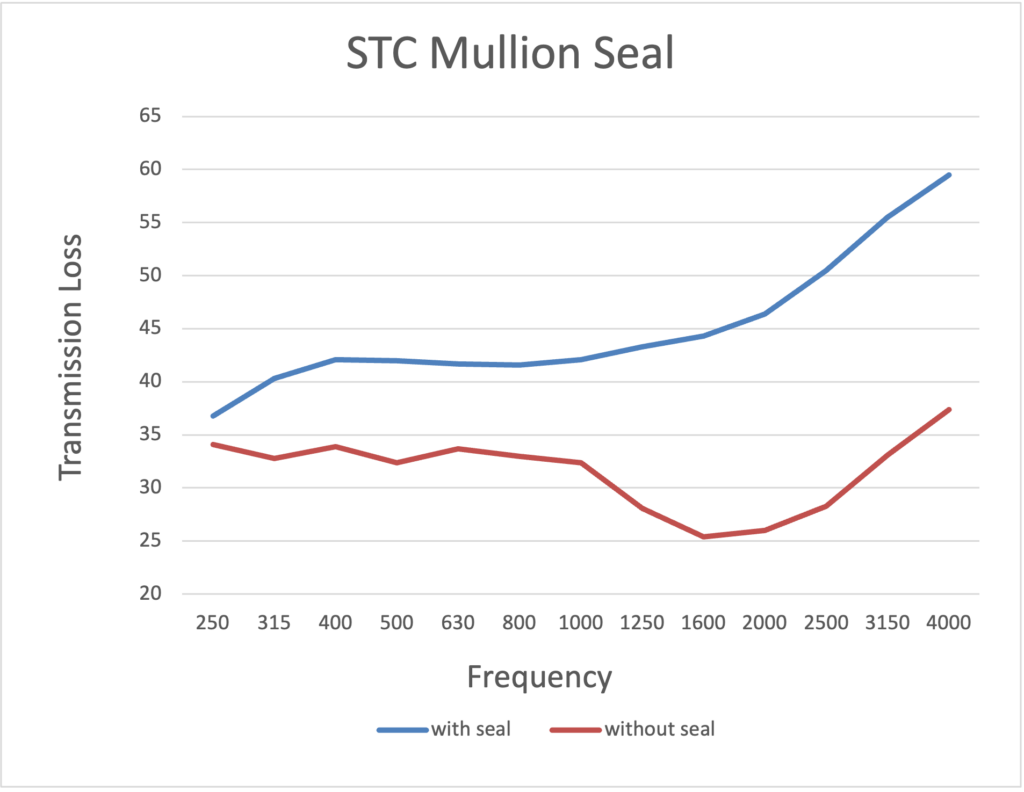- (716) 839-0900
- info@stcsoundcontrol.com
Many buildings of all types have large, continuous spans of glass at the outside wall referred to as curtainwall, storefront systems or ribbon windows. Room partitions at the outside wall are usually run into mullions (vertical, thin metal tubes that hold the glass in place) rather than into the glass itself. The joint between the mullion and partition has a gap, or sound flanking path, due to the movement of the exterior glass wall relative to the interior partition. This gap lets sound pass between rooms on either side of the partition, which ultimately defeats the purpose of the wall. In addition, lease agreements often prohibit tenants (and their contractors) from connecting drywall partitions to the mullions.
The STC Mullion Seal closes this gap to prevent sound from traveling and enhances acoustical comfort in spaces with these exterior glass walls.
Made of neoprene rubber, the Mullion Seal effectively seals the gap for sound isolation. A pressure sensitive adhesive strip on each side seals the rubber to the mullion and the partition.
Wind loads, interstory drift, and thermal expansion all cause the gap between the mullion and partition to widen and close. The patented special profile and adhesion pattern allows this movement without breaking the seal unlike foam and rubber double-sided tapes.
The Mullion Seal can be used in a variety of environments that feature glass windows or partitions.
 Mullion Seal has a number of benefits over competitive products, including:
Mullion Seal has a number of benefits over competitive products, including:
The STC Mullion Seal is designed to effectively seal the joint between mullions and partitions, maintaining balance in the acoustical design at minimal cost. For example, typical offices have background noise at NC-30 to NC-35, and have sound absorbing carpet and acoustic ceilings that assist in attaining acoustical comfort. An office partition of STC-47 achieves an effective STC-43 for the overall separation, blocking even loud speech at 72 dBA. Unsealed, the effective value drops to STC-36. Covered mullions can achieve higher values, but are unnecessary and 20 times the cost.
Section 061600 “Sheathing” as an Acoustical Accessory for Underlayment Systems, under Miscellaneous Materials.

Neoprene, a dense and resilient rubber selected for its ability to isolate sound and vibrations. Neoprene also remains extremely flexible and does not deteriorate with exposure to ultraviolet light.
No. The interior partition that sits on the floor, and the mullion that is connected to the exterior wall, are allowed to move in relation to each other. Offset pressure sensitive adhesive strips (PSA) connect the Mullion Seal to both the partition and the mullion.
Prior to constructing the partition at the mullion cut the flat profile seals to length. Short leftover pieces may be butted together. Remove the protective cover on the mullion-side PSA strip (keep the cover on the wall-side PSA during this step), set in place and apply pressure. Prepare a small pre-finished section of partition, usually of the same depth as the spandrel shelf, complete with corner trim and compound, perhaps even sanded and painted. Remove the PSA cover strip from the partition side of the seal and immediately set the prepared section of partition in place, applying pressure to set the adhesive.
Custom cove profile will require trimming of the cove edge where it passes by horizontal mullions including top, bottom and any intermediates.
The standard color is black rubber. Contact the factory for custom colors; minimum order quantities (MOQ) will be required for custom colors.
The joint between partitions and mullions can be a major sound flanking path, especially when building standards do not allow rigid attachment of the partitions to the mullions, and when there is expected interstory drift, thermal expansion, and wind load deflection. Independent tests by NGC show a Transmission Loss differential of 15 dBA at middle and high frequencies between sealed and unsealed joints, a substantial difference.
Legal Name: STC Architectural Products LLC
Assumed Name: STC Sound Control
1200 Northland Ave. Buffalo, NY 14215
Telephone: 716-839-0900
E-mail: info@stcsoundcontrol.com
STC Sound Control makes acoustical products for architecture that minimize the annoyance and aggravation related to noise…..read more